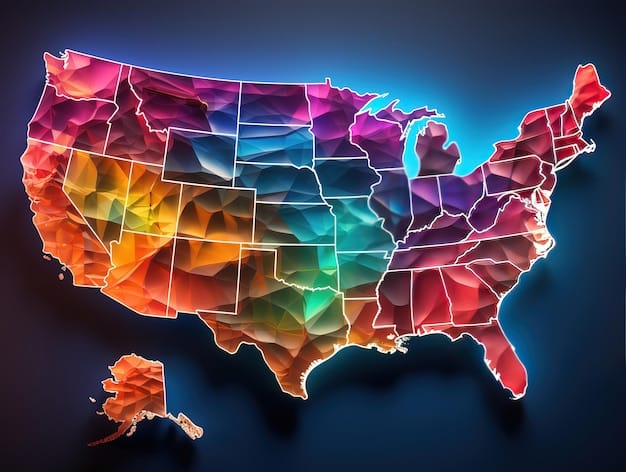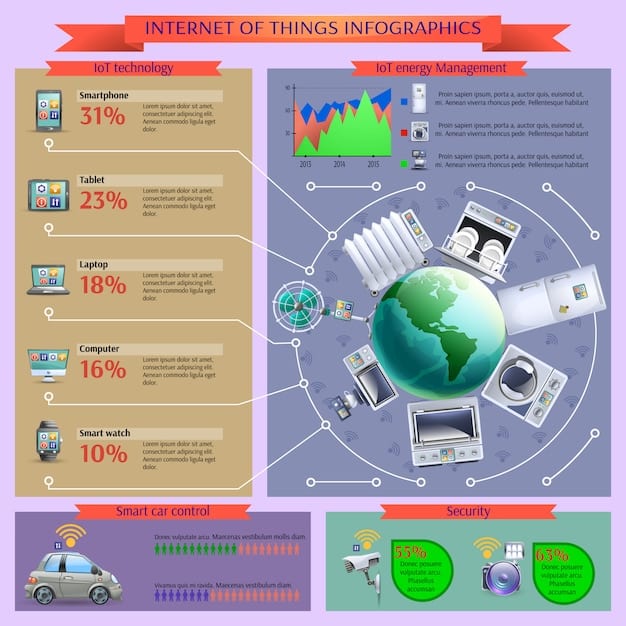Tech e Society Article – tech_e_soc_changesnewcom_36_1757442035_042dabb7_what_are_t.html

The US government is actively deploying a multi-faceted approach, including significant funding, legislative frameworks, and strategic partnerships, to bridge the digital divide in underserved communities, ensuring equitable access to high-speed internet and digital literacy resources nationwide.
The digital divide, a persistent chasm separating those with access to modern information and communications technology from those without, remains a critical challenge in the United States. In recent years, recognizing the fundamental role of digital connectivity in economic opportunity, education, and civic participation, the US government has intensified its efforts to address this disparity. This article explores what are the latest government initiatives to bridge the digital divide in underserved communities in the US, examining the legislative, financial, and programmatic strategies being deployed to ensure equitable access for all Americans.
Understanding the Digital Divide in the US
The digital divide in the United States is more than just a lack of internet access; it encompasses disparities in broadband infrastructure, device availability, digital literacy skills, and affordability. These interconnected issues disproportionately affect rural areas, low-income households, tribal communities, and certain racial and ethnic groups, exacerbating existing inequalities.
For many years, the debate centered primarily on broadband availability. However, as connectivity became increasingly essential for daily life – from remote work and online learning to telehealth appointments and accessing government services – the complexity of the divide became more apparent. It’s not enough to simply lay fiber if people cannot afford the service, lack the devices to use it, or possess the skills to navigate the digital world effectively.
Historical Context and Evolving Challenges
The concept of the digital divide emerged in the mid-1990s, highlighting the gap in internet access between different socioeconomic groups. Initially, it was perceived as a temporary phenomenon that market forces would eventually close. However, the persistence of the divide underscored the need for government intervention.
Today’s challenges are amplified by the rapid evolution of technology. As bandwidth demands increase and new digital skills become requisite for employment, communities with inadequate infrastructure risk falling further behind. The COVID-19 pandemic vividly demonstrated the critical importance of reliable internet access, exposing the vulnerabilities of millions who lacked dependable connectivity for work, education, and healthcare.
- Broadband Infrastructure: Many rural and remote areas still lack the physical infrastructure for high-speed internet.
- Affordability: Even where infrastructure exists, the cost of internet service and devices can be prohibitive for low-income families.
- Digital Literacy: A significant portion of the population lacks the necessary skills to effectively use digital tools and navigate the internet safely.
- Device Access: Affordable and reliable computers or tablets are not universally available, creating a barrier to participation.
Addressing these multifaceted challenges requires a holistic approach, one that integrates infrastructure development with programs promoting affordability, digital literacy, and device access. The latest government initiatives reflect this comprehensive understanding, aiming to tackle the problem from multiple angles rather than focusing on a single symptom.
Key Legislative Frameworks and Funding
The cornerstone of the US government’s recent efforts to bridge the digital divide lies in landmark legislation and unprecedented funding allocations. These initiatives represent a significant shift from previous, more fragmented approaches, signaling a robust commitment to universal connectivity.
Perhaps the most impactful legislation is the Infrastructure Investment and Jobs Act (IIJA), signed into law in November 2021. This bipartisan bill allocated tens of billions of dollars specifically towards broadband expansion and digital equity programs, recognizing that modern infrastructure extends beyond roads and bridges to include high-speed internet.
The Infrastructure Investment and Jobs Act (IIJA)
The IIJA includes several key programs designed to tackle various facets of the digital divide. The largest component by far is the Broadband Equity, Access, and Deployment (BEAD) Program. Administered by the National Telecommunications and Information Administration (NTIA), BEAD earmarks $42.45 billion to expand high-speed internet access in unserved and underserved areas across the country. This funding is distributed to states and territories, which then develop their own plans to deploy broadband infrastructure.
Another crucial component is the Affordable Connectivity Program (ACP), which provides a monthly discount on internet service for eligible low-income households. While not directly funded by the IIJA, the IIJA extended its funding. This program addresses the critical issue of affordability, ensuring that even when infrastructure is available, the cost doesn’t prevent access.
- BEAD Program ($42.45 billion): Focuses on deploying broadband infrastructure in unserved and underserved locations.
- Affordable Connectivity Program (ACP): Provides subsidies to make internet service more affordable for low-income households.
- Digital Equity Act Programs ($2.75 billion): Funds state digital equity plans and competitive grants to promote digital literacy and inclusion.
These initiatives aim to create a comprehensive framework for universal broadband access and digital inclusion. The decentralized approach, allowing states to tailor programs to their specific needs, is a key feature, recognizing the diverse landscape of digital inequity across the nation.

Programs for Broadband Infrastructure Deployment
A primary focus of current government initiatives is the physical expansion of broadband infrastructure, particularly in rural and tribal communities where access is most limited. This requires significant investment and coordination to ensure that new networks are robust, future-proof, and can deliver high-speed, reliable service.
The BEAD program, as mentioned, is at the forefront of these efforts. States are now in the process of submitting their initial proposals and five-year action plans to the NTIA, outlining how they intend to use their allocations to achieve universal broadband coverage. These plans emphasize not just deployment, but also the engagement of local communities and the adoption of future-proof fiber optic technologies.
NTIA’s Role and State Initiatives
The National Telecommunications and Information Administration (NTIA) plays a central role in overseeing these programs. Beyond BEAD, the NTIA also manages other significant initiatives, such as the Tribal Broadband Connectivity Program and the Middle Mile Broadband Infrastructure Program.
The Tribal Broadband Connectivity Program provides funding directly to tribal governments for broadband deployment on tribal lands, addressing historical underinvestment in these areas. The Middle Mile Broadband Infrastructure Program aims to reduce the cost of broadband deployment by funding the construction of “middle mile” infrastructure, which connects local networks to national backbones, making it easier and cheaper for internet service providers to extend their services to unserved areas.
- BEAD Program: States are developing comprehensive plans to deploy fiber and other advanced technologies.
- Tribal Broadband Connectivity Program: Focused grants for broadband infrastructure in tribal communities.
- Middle Mile Broadband Infrastructure Program: Aims to reduce deployment costs by funding critical network infrastructure.
These infrastructure-centric programs represent a monumental undertaking, requiring collaboration between federal, state, local, and even private entities. The goal is not just to close the current access gaps, but to establish a resilient digital foundation for future generations.
Initiatives for Digital Affordability and Equity
Beyond infrastructure, the government is acutely aware that even the presence of a fiber optic cable does not guarantee internet access if the service is unaffordable or if individuals lack the skills and devices to use it. Consequently, significant initiatives are in place to address the affordability of internet service and to promote digital literacy and inclusion.
The Affordable Connectivity Program (ACP) stands out as a critical tool in this regard. Providing a monthly discount of up to $30 on internet service (and up to $75 for households on tribal lands), the ACP has helped tens of millions of low-income families connect to the internet. This subsidy directly tackles the economic barrier to entry, making broadband accessible to those who previously could not afford it.
The Affordable Connectivity Program (ACP)
The success of the ACP has been widely recognized, with millions of households enrolling since its inception. It operates by providing a direct subsidy to internet service providers, who then pass the savings on to eligible customers. Eligibility criteria typically include participation in other federal assistance programs like SNAP, Medicaid, or Pell Grants.
While extremely effective, the ACP faces potential funding cliffs, generating discussions about its long-term sustainability and the need for continued appropriations. Its importance cannot be overstated, as it provides an immediate lifeline to connectivity for vulnerable populations, complementing the slower and more capital-intensive process of infrastructure buildout.
Digital Equity Act Programs
The Digital Equity Act, also part of the IIJA, dedicates $2.75 billion to ensure that individuals and communities have the skills, technology, and capacity needed to reap the benefits of the digital economy. This funding is divided into three components:
- State Digital Equity Capacity Grant Program: Provides planning and implementation grants to states to develop and execute their own digital equity plans.
- Digital Equity Competitive Grant Program: Awards grants to a wide range of organizations, including nonprofits, community anchor institutions, and local governments, for innovative digital equity projects.
- Connecting Minority Communities Pilot Program: Focuses on historically Black colleges and universities (HBCUs), tribal colleges and universities (TCUs), and other minority-serving institutions.
These programs address the human element of the digital divide, focusing on digital literacy training, device distribution, and providing technical support to help people effectively use their internet connections. This comprehensive strategy ensures that access is not just about wires in the ground, but about empowering individuals with the tools and knowledge to thrive in a digital world.
Specialized Initiatives for Specific Underserved Populations
Recognizing that the digital divide manifests differently across various communities, the US government has also launched specialized initiatives tailored to the unique needs of specific underserved populations. These programs often involve direct engagement with community leaders and organizations to ensure that solutions are culturally appropriate and effective.
Tribal communities, for instance, have historically faced profound challenges in broadband access due to complex land ownership issues, remote locations, and a lack of investment. The Tribal Broadband Connectivity Program, mentioned earlier, is a direct response to this disparity, allocating significant funds for broadband infrastructure and digital inclusion initiatives on tribal lands.
Focus on Rural, Tribal, and Low-Income Communities
Beyond the Tribal Broadband Connectivity Program, other initiatives specifically target rural America. Programs like the USDA’s ReConnect Program, while not new, continue to be a vital source of funding for broadband deployment in unserved rural areas. ReConnect loans and grants help finance the construction of broadband networks, bridging gaps where private providers have been hesitant to invest due to perceived low returns.
For low-income communities, the focus extends beyond the ACP to partnerships with local organizations that provide free or low-cost devices and digital literacy training. Libraries, community centers, and non-profits often serve as critical access points, offering public computers, Wi-Fi hotspots, and classes on digital skills, from basic computer navigation to online job searching.
- Tribal Broadband Connectivity Program: Addressing the unique challenges of broadband deployment on tribal lands.
- USDA ReConnect Program: Long-standing initiative providing loans and grants for rural broadband development.
- Community Anchor Institutions: Supporting libraries and community centers as hubs for digital access and learning.
These tailored approaches acknowledge the diverse nature of underserved communities and aim to build sustainable digital ecosystems that reflect local needs and priorities. The success of these initiatives often hinges on strong community partnerships and a bottom-up approach to problem-solving.
Future Outlook and Challenges Remaining
While the recent government initiatives represent an unprecedented commitment to bridging the digital divide, the task is far from complete. Significant challenges remain, and the long-term success of these programs will depend on sustained political will, effective implementation, and adaptability to an evolving technological landscape.
One of the foremost challenges is the sheer scale of the infrastructure buildout required. Deploying fiber to every unserved location across the vastness of the US is an enormous undertaking, fraught with logistical complexities, labor shortages, and potential supply chain issues. Ensuring efficient use of funds and avoiding duplication of effort will be crucial.
Sustainability and Evolving Technologies
The sustainability of programs like the Affordable Connectivity Program is also a key concern. As the initial funding for the ACP runs out, there will be a need for continued appropriations to prevent millions of families from losing their internet subsidies. Without addressing the long-term funding for affordability, the gains made in infrastructure deployment might not translate into actual access for those who need it most.
Moreover, technology continues to advance rapidly. What constitutes “high-speed broadband” today may be insufficient a decade from now. Initiatives must be designed with future-proofing in mind, investing in scalable technologies that can adapt to increasing bandwidth demands and emerging applications. The digital skills gap is also continually shifting, requiring ongoing education and training programs to keep pace.
- Infrastructure Deployment Magnitude: The immense logistical challenge of reaching every unserved area.
- Affordability Program Funding: Ensuring long-term, sustainable funding for programs like the ACP.
- Technological Evolution: Future-proofing networks and programs against rapid advancements in digital tools and services.
- Digital Skill Imperative: The need for continuous digital literacy and workforce development training.
The journey to full digital inclusion is a marathon, not a sprint. It requires continuous re-evaluation, adaptation, and a collaborative spirit among government agencies, private industry, and community organizations. While significant strides have been made, sustained vigilance and investment will be necessary to ensure that no American is left behind in the digital age.
| Key Initiative | Brief Description |
|---|---|
| 🚀 BEAD Program | $42.45B for high-speed internet infrastructure in unserved and underserved areas. |
| 💰 Affordable Connectivity Program (ACP) | Monthly discount on internet service for eligible low-income households. |
| 📚 Digital Equity Act Programs | Funds for digital literacy, skills training, and device access across states. |
| 🤝 Tribal Broadband Connectivity | Direct funding for broadband infrastructure and digital inclusion in tribal lands. |

Frequently Asked Questions About Bridging the Digital Divide
The primary goal of the BEAD Program is to ensure that every American has access to affordable, reliable, high-speed internet. It aims to achieve this by funding the deployment of broadband infrastructure in unserved and underserved areas across the United States, prioritizing locations completely lacking reliable internet service or those with insufficient speeds.
The ACP directly addresses the affordability barrier by providing a monthly discount on internet service for eligible low-income households. This makes it possible for millions of families who might otherwise struggle to afford internet to gain access, thereby ensuring that even with infrastructure in place, cost does not prevent connectivity.
Digital equity funds, such as those from the Digital Equity Act, are crucial because they ensure people have the skills, devices, and support needed to use their internet connections effectively. Without digital literacy and access to devices, simply having broadband infrastructure doesn’t guarantee meaningful participation in the digital world for underserved communities.
Yes, tribal communities are specifically targeted through initiatives like the Tribal Broadband Connectivity Program. This program provides direct funding to tribal governments for broadband deployment and digital inclusion efforts on tribal lands, addressing historical disparities and unique challenges faced by these communities in obtaining internet access.
Significant challenges include the immense logistical scale of infrastructure deployment, ensuring long-term sustainable funding for affordability programs like the ACP, and adapting to rapidly evolving technological advancements. Continuous effort is also needed to address the ongoing digital skills gap and ensure equitable access to devices for all citizens.
Conclusion
The US government’s current initiatives to bridge the digital divide represent a monumental commitment to ensuring equitable access to the internet for all Americans. Through comprehensive legislative frameworks like the Infrastructure Investment and Jobs Act, the significant allocation of funds to programs like BEAD, ACP, and the Digital Equity Act, and specialized efforts for tribal and rural communities, a multi-faceted approach is firmly in place. While the path to universal digital inclusion is challenging and ongoing, these bold steps are pivotal in laying the foundation for a more connected, equitable, and economically vibrant future for underserved communities across the nation. The success of these programs will ultimately depend on sustained investment, effective implementation, and a continued focus on both infrastructure and the human element of digital empowerment.





